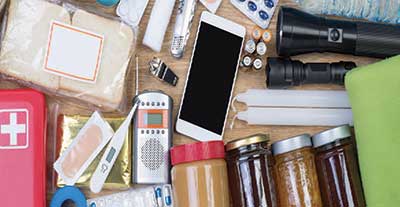(The information below is provided by the National Safety Council.)
Emergency situations can happen at any time, making it crucial that you are prepared for the unexpected long before it happens.

Plan for Possible Emergencies
- Research and prepare for natural disasters common to your area, such as floods, earthquakes or tornadoes
- Create an emergency kit for both your home and car
- Create a home emergency plan with your family and learn how to shut off your utilities
- Be a good participant in emergency drills at work and school by following instructions and paying attention to lessons learned
- Store important phone numbers, including those of family members, with other important documents in a fire-proof safe or safety deposit box
- Learn first aid and CPR for children and adults – check out the NSC First Aid app
- Know how to respond to an active shooter with free NSC training

Stock Your Emergency Kits Now
Emergency kits can help you prepare for the worst, but only if they are properly stocked and regularly refreshed. Your home emergency kit should be very accessible and contain:
- Food and water for each family member for three days as well as a can opener and nonperishable foods, such as tuna and peanut butter
- Hand-crank or battery-powered flashlight and radio with extra batteries
- Full first aid kit, including hand sanitizer and garbage bags
- Plastic sheeting and duct tape for broken windows or a leaky roof
- Whistle to signal for help so rescuers can locate you
Your car emergency kit should contain:
- A properly inflated spare tire, wheel wrench, tripod jack and jumper cables
- A tool kit, compass, duct tape and car charger for your cell phone
- A flashlight with extra batteries, a rain poncho and a fire extinguisher
- Reflective triangles and vest, and brightly colored cloth to make your vehicle more visible
- A first aid kit and enough nonperishable food and water for three days
- Cold weather items such as a snow brush, shovel, windshield washer fluid, warm clothing, cat litter for traction and blankets
One step for safety: Change the batteries in your smoke alarms at least once each year. A working smoke alarm cuts your odds of dying in a home fire in half, according to the National Fire Protection Association.
Related Articles
- Is Your Workplace Prepared for a Tornado?
- More Than Half of Workers Aren’t Trained on First Aid, CPR: Survey
